|
These fibres have been an exciting new development in the world of textile fibres that has revolutionised the use of sparkle in all fabric. The fibre has a super soft handle, much like cashmere, but has been produced in such a way that even just a little added to a fibre mix will result in a sparkling effect. Angelina Fibres can be spun, woven, layered, trapped, bonded etc. Its applications in textile art, embroidery, felt making, papermaking, modelling, card and candle-making etc, are endless. There are two types of Angelina fibres - Hot Fix and Standard. 'Hot Fix' Angelina Fibre Heat-bondable Iridescent Fibres. Soft lustrous fibre that will bond to itself at relatively low temperatures to produce a non-woven type of fabric. Bonding occurs when the 'hot-fix' Angelina fibres soften and fuse together. Start by testing the procedure. Simply place a small amount of fibre between two sheets of baking parchment. Using an iron on the 'silk' setting (irons vary so start with this setting - it may be necessary to increase the temperature, but avoid using too hot a setting to start with as this will affect the overall result), gently move the iron back and forth over the surface of the tissue. The fibres will bond quickly, so check frequently to see the progress. Too much heat or pressure can change the original qualities of the fibre. Generally, at low temperatures 'Hot Fix' Angelina will only bond to itself not to other fibres or paper. The result will be a sheet of web-like non-woven sparkling fabric that is peeled off the baking parchment. The fibres can be blended for shimmering multi-coloured effects. Quite solid, dense sheets of fabric can be produced simply by using a larger amount of fibre without spreading or thinning. In this case, it may be necessary to increase the temperature slightly while applying the heat for longer, and to turn the whole Angelina 'sandwich' over and iron on the reverse side. 'Standard' Angelina Fibre Non-bondable Iridescent/Metallic Fibres. Due to the make-up of the 'Hot Fix' colours, they are not produced in metallic shades, but these non-bondable colours complement the 'Hot Fix' range. These fibres have a super-soft handle and can be spun, woven, included in papermaking etc just like the 'Hot Fix' fibres, but they will not bond to themselves at the low temperatures as used with 'Hot Fix'. 'Standard' Fibres can be combined with 'Hot Fix' to give an added metallic 'glitz'. The trick is to lay a quantity of 'Hot Fix' fibres down onto baking parchment, add a smaller quantity of the metallic 'Standard' fibre over making sure the fibres are spread and open (not in clumps) and add another layer of 'Hot Fix' over the top. Heat to bond the fibres in the normal way. The 'Standard' fibres are then trapped within the fabric and will remain stable unless so much 'Standard' fibre was used that it could not be successfully held by the 'Hot Fix'. In this case, the 'Standard' fibres will loosen out of the fabric. Ideas to try: Prepare several sheets of fine 'Hot Fix'. Using one as a base, cut strips/shapes from the others and place onto the base. Heat again. The shapes will now be bonded onto the base sheet. Other layers can be added, but it may be necessary to increase the temperature and 'dwell' time for successful bonding Increase the temperature of the iron and see the difference it makes to the 'Hot Fix' colours. The higher the temperature, and the longer the 'dwell' time the more matt the colours become. In a sheet of mixed fibre ('Hot Fix' & 'Standard'), increasing the temperature of the iron will make the 'Hot Fix' colours more matte, but will not affect the 'Standard' colour and therefore make those metallic fibres more obvious. Angelina is a polyester fibre and is therefore perfect for transfer paints. Apply Transfer Paints or Crayons onto paper, place face down onto the prepared fabric sheet of Angelina and iron. The image will be transferred to the Angelina fabric, giving a new dimension to the colours. Pleat or crimp the sheet of Angelina fabric. To change and matt the colour in small areas, apply ChromaCoal which should be heat-set in the normal way. Apply metallic foil to a prepared sheet of Angelina fabric. Place foil over the sheet, following the foil instructions, protect with baking parchment and use the iron to transfer the foil colour onto the Angelina fabric sheet. Or, place foil over the Angelina sheet and with baking parchment in place, draw a pattern with the tip of the iron - the foil will be transferred to the sheet in that pattern. To apply Angelina fibres to other surfaces, use PVA for scrap-booking and other paper-like collages or use fusible webbing for fabric surfaces.
|
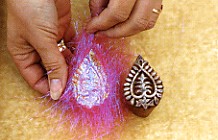 Impressing
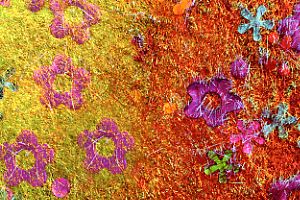 With sequins, sprinkles and mica flakes
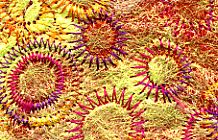 Flower stitch worked on Angelina.
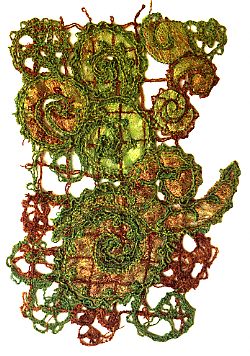 Angelina piece.
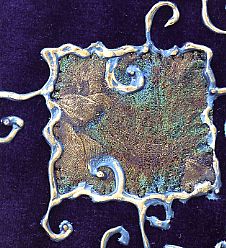 Embellished blue velvet.
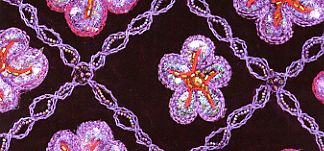 Angelina flowers. |

back to fibres
top